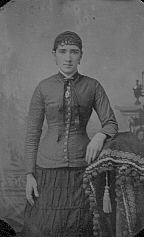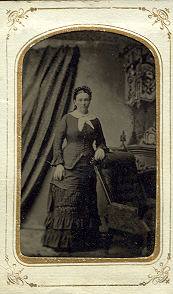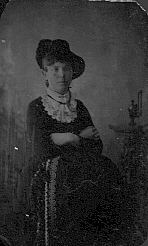More Mid Nineteenth Century Dress
12 tintypes from the same album...
 The earliest tintype in the collection. I haven't seen an example of a neckline like this before, but the shoulder seams, general line of the dress and hairstyle are from the early 1860s. The sleeves appear to be pagoda sleeves, they don't have a cuff and you can see quite a bit of the undersleeve peeking out. The dent in her right shoulder is a white bow that is tied at the base of ther neck. Though impossible to tell in the scan, the original shows a ridge on the back of her head, possibly a decorative hairnet. There's a sprig of flowers coming out of her hair on her left side. She wears rather large drop earrings.
The earliest tintype in the collection. I haven't seen an example of a neckline like this before, but the shoulder seams, general line of the dress and hairstyle are from the early 1860s. The sleeves appear to be pagoda sleeves, they don't have a cuff and you can see quite a bit of the undersleeve peeking out. The dent in her right shoulder is a white bow that is tied at the base of ther neck. Though impossible to tell in the scan, the original shows a ridge on the back of her head, possibly a decorative hairnet. There's a sprig of flowers coming out of her hair on her left side. She wears rather large drop earrings.
 The skirt on this dress is held out by a hoop in front, as well as a bustle in back, showing the transition between the two styles.
The skirt on this dress is held out by a hoop in front, as well as a bustle in back, showing the transition between the two styles.
 I love the details on this dress, the buttons, lace, fabric changes. It's a good example of how the sewing machine helped make dresses more decorative.
I love the details on this dress, the buttons, lace, fabric changes. It's a good example of how the sewing machine helped make dresses more decorative.
 This bodice is very similar to a dress in Jane Ashelford's The Art of Dress, dated 1875 (page 226). The bodice is extremely tight. I enjoy seeing details like the waistline creases, they show that dresses weren't always perfect. :)
This bodice is very similar to a dress in Jane Ashelford's The Art of Dress, dated 1875 (page 226). The bodice is extremely tight. I enjoy seeing details like the waistline creases, they show that dresses weren't always perfect. :)
 This dress is very reminiscent of the Jersey costume popularized by Lilly Langtry in the late 1870s. You can see the ridge created by the edges of her corset easily.
This dress is very reminiscent of the Jersey costume popularized by Lilly Langtry in the late 1870s. You can see the ridge created by the edges of her corset easily.
 A similar tight bodice to the picture above...
A similar tight bodice to the picture above...
 The most striking feature of this dress is the collar. The dress below the collar consists of a perfectly fitting smooth bodice with a skirt with the fullness pulled towards the back.
The most striking feature of this dress is the collar. The dress below the collar consists of a perfectly fitting smooth bodice with a skirt with the fullness pulled towards the back.
 Another example of a tight, smooth bodice. Unlike the above examples, this dress has a rather large bustle in back (obvious in orginal). The skirt is draped smoothly over the bustle with no ruffles.
Another example of a tight, smooth bodice. Unlike the above examples, this dress has a rather large bustle in back (obvious in orginal). The skirt is draped smoothly over the bustle with no ruffles.




I have to admit, the only thing I really know about men's clothing is that they wore clothing. Still, the pictures are interesting.
Fashion Plates and Photos Home
Photos, Page One
 Home, Jeeves
Home, Jeeves

 The earliest tintype in the collection. I haven't seen an example of a neckline like this before, but the shoulder seams, general line of the dress and hairstyle are from the early 1860s. The sleeves appear to be pagoda sleeves, they don't have a cuff and you can see quite a bit of the undersleeve peeking out. The dent in her right shoulder is a white bow that is tied at the base of ther neck. Though impossible to tell in the scan, the original shows a ridge on the back of her head, possibly a decorative hairnet. There's a sprig of flowers coming out of her hair on her left side. She wears rather large drop earrings.
The earliest tintype in the collection. I haven't seen an example of a neckline like this before, but the shoulder seams, general line of the dress and hairstyle are from the early 1860s. The sleeves appear to be pagoda sleeves, they don't have a cuff and you can see quite a bit of the undersleeve peeking out. The dent in her right shoulder is a white bow that is tied at the base of ther neck. Though impossible to tell in the scan, the original shows a ridge on the back of her head, possibly a decorative hairnet. There's a sprig of flowers coming out of her hair on her left side. She wears rather large drop earrings.  The skirt on this dress is held out by a hoop in front, as well as a bustle in back, showing the transition between the two styles.
The skirt on this dress is held out by a hoop in front, as well as a bustle in back, showing the transition between the two styles.  I love the details on this dress, the buttons, lace, fabric changes. It's a good example of how the sewing machine helped make dresses more decorative.
I love the details on this dress, the buttons, lace, fabric changes. It's a good example of how the sewing machine helped make dresses more decorative. This bodice is very similar to a dress in Jane Ashelford's The Art of Dress, dated 1875 (page 226). The bodice is extremely tight. I enjoy seeing details like the waistline creases, they show that dresses weren't always perfect. :)
This bodice is very similar to a dress in Jane Ashelford's The Art of Dress, dated 1875 (page 226). The bodice is extremely tight. I enjoy seeing details like the waistline creases, they show that dresses weren't always perfect. :) This dress is very reminiscent of the Jersey costume popularized by Lilly Langtry in the late 1870s. You can see the ridge created by the edges of her corset easily.
This dress is very reminiscent of the Jersey costume popularized by Lilly Langtry in the late 1870s. You can see the ridge created by the edges of her corset easily.  A similar tight bodice to the picture above...
A similar tight bodice to the picture above... The most striking feature of this dress is the collar. The dress below the collar consists of a perfectly fitting smooth bodice with a skirt with the fullness pulled towards the back.
The most striking feature of this dress is the collar. The dress below the collar consists of a perfectly fitting smooth bodice with a skirt with the fullness pulled towards the back. Another example of a tight, smooth bodice. Unlike the above examples, this dress has a rather large bustle in back (obvious in orginal). The skirt is draped smoothly over the bustle with no ruffles.
Another example of a tight, smooth bodice. Unlike the above examples, this dress has a rather large bustle in back (obvious in orginal). The skirt is draped smoothly over the bustle with no ruffles.



 Home, Jeeves
Home, Jeeves